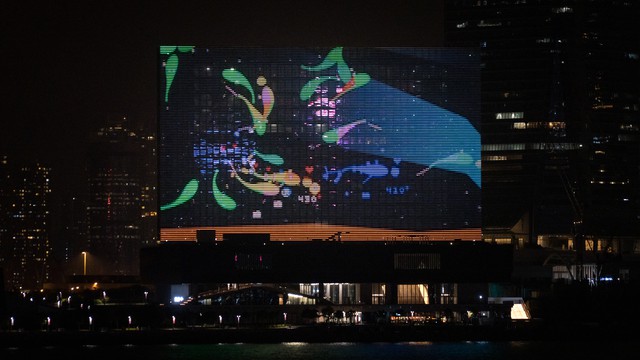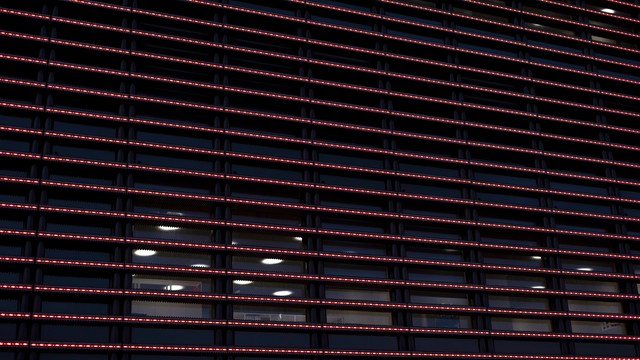M+ Facade 2021, Hong Kong, Hong Kong
An iconic curatorial space and evolving digital platform for site-specific artistic commissions and museum collection works.




Overlooking Hong Kong's Victoria Harbour, the M+ Facade lights up nightly as one of the largest art screens in the world. At 65.8m tall by 110m wide, it is visible up to 1.5km away when viewed on Hong Kong Island. Part physical, part digital, this enormous light-powered canvas, embedded with more than 5,600 LEDs, enlivens the city's famous skyline, and is a key point of connection with the museum's audiences. The M+ Facade transports the M+ Collections and programmes beyond the walls of the museum, bringing contemporary visual art, design and architecture, and moving image into direct dialogue with the visual culture of the city. As a curatorial space, it offers moments of play, humour, intellectual reflection, and meditative contemplation to thousands of onlookers, from 6-10pm every night. Bespoke artworks custom-made for the M+ Facade, amplify the M+ building's unique architectural qualities, at the same time activating lively conversations with the surrounding cityscape and people of Hong Kong.
M+ is Asia’s first global museum of contemporary visual culture, dedicated to collecting, exhibiting, and interpreting visual art, design and architecture, moving image, and Hong Kong visual culture of the 20th and 21st centuries. The M+ Facade presents and promotes this content to the public. Boasting the world’s first ‘hybrid’ LED system, the M+ Facade comprises wide-beam lights for close-up viewing, and narrow-beam lights for viewing from afar, ensuring exceptional audience visibility from different viewing angles and distances. A light sensor measures surrounding ambient light, automatically calibrating the brightness and colour of the display, in real time. The M+ Facade launched on 13 October 2021, one month before the opening of the museum on 12th November. Since then, M+ has exhibited museum branding and promotions on the M+ Facade, alongside three site-specific commissioned artworks, and hundreds of M+ Collection highlights. The inaugural commission for the space was created by the Dutch interactive-design studio Moniker. 'Touch for Luck' (2022) was a participatory ‘art game’ that launched on 27 January 2022, in celebration of Chinese New Year. More than 25,000 people, from nearly 100 countries, played the game. Conceptually, the work explored the lure of social media and the pervasive influence of networked technologies on our daily lives. To engage, users were invited to touch their mobile-phone screens without letting go, all-the-while accumulating lucky charms and connecting with other players on the M+ Facade. Each player’s avatar was an animated koi goldfish. Collectively, the players transformed the expansive M+ Facade into a hypnotic fishpond floating above Victoria Harbour. International players and audiences could view the communal artwork through the M+ Facade livestream: www.mplus.org.hk/en/mplus-facade/ 'The Shape of Light' (2022) by Hong Kong moving image pioneer Ellen Pau, was another bespoke, site-specific moving image work that premiered on 20 May 2022. Using digitally animated special effects, this meditative work featured The Heart Sutra expressed through sign language. The sutra’s core themes of light and darkness, and form and emptiness, resonated with Pau’s longstanding engagement with video’s formal and material qualities, as well as the work’s presence in West Kowloon as part of Hong Kong’s glowing skyline. Fire, water, and light were all rendered in awe-inspiring CGI animation, which danced with the ambient light inside the M+ building and the surrounding cityscape. Describing the M+ Facade as a 'digital lighthouse', Pau sought to provide guidance and hope for the Hong Kong people impacted by COVID-19. As an artist long attuned to the city’s emotional undercurrents, Pau aimed to heal Hong Kong by reminding people of the interdependence of all phenomena—the physical and the psychological, the material and the immaterial. In 'The Shape of Light', the M+ building, the city, and its people were one.
https://www.mplus.org.hk/en/mplus-facade/
Details
Building or project owner : M Plus Museum Limited
Architecture : Building design by Herzog & de Meuron in partnership with TFP Farrells and Arup
Project artist/ concept/ design/ planning : iart - studio for media architectures (facade concept development and design)
Structural engineering : Arup
Facade design : Herzog & de Meuron / iart - studio for media architectures / Arup
Facade construction : Permasteelisa
Light design : iart - studio for media architectures
Technical layout light : iart - studio for media architectures / Arup
Display content/ visuals/ showreel : Curated and commissioned by M+
Light hardware (LED hardware) : Traxon Technologies
Lighting control software : iart - studio for media architectures (AEPOS playout system), Traxon Technologies (e:cue)
Project co-ordination : West Kowloon Cultural District Authority
Membrane skin : None
Project sponsor/ support : One artist commission, 'The Shape of Light' by Ellen Pau, was co-commissioned with Art Basel and sponsored by UBS.
Descriptions
Facade type and geometry (structure) : The M+ Facade measures 65.8 metres in height and 110 metres in width. Its surface is covered with ceramic louvers, which the architects developed especially for the museum. Two different types of LED are integrated into the ceramic louvers of the facade that faces Victoria Harbour. They form a hybrid display system that makes content visible under different lighting conditions and from different angles and distances. The LEDs are embedded into the facade in such a way that they are barely visible when switched off.
Kind of light creation : The M+ Facade consists of two different types of LEDs: focused high-power LEDs, which are best viewed from a distance, and diffuse low-power LEDs, whose visibility is best close up, from the museum's podium roof garden. The layers can be controlled independently to generate an illusion of depth. Thus, in the evening hours, the M+ Facade display can be seen from the surrounding art park, as well as from Hong Kong Island across the harbour.
Resolution and transmitting behaviour : The virtual resolution of the M+ Facade is 2816 x 1686 pixels. This is the format in which the content is created. It is then mapped onto the physical display, which consists of 118 horizontal LED rows integrated into the facade and thus has a resolution of 2816 x 118 pixels. The human eye automatically fills in the missing image content. Each row features 2100 low-power LEDs and 716 high-power LEDs. The high-power LEDs have a narrow beam angle and the low-power LEDs have a wide beam angle. They are 8bit RGB LEDs, so the colour depth is 24 bits. Content is displayed at 30 fps.
Pixel distance : In the vertical direction, the pixel distance is 560 millimetres, and in the horizontal direction it is 50 millimetres. Every third pixel is a high-power LED.
Luminace : An algorithm was implemented to ensure that the M+ Facade is just bright enough for content to be visible, while keeping light emission at a minimum. Sensors measure the ambient light, and the brightness of the facade is adjusted accordingly. The interplay of the LED facade, ambient light, and artificial light in and behind the building is balanced to create an optimal experience for the viewer. This also changes the perceived depth of the facade: at dusk, it appears as a semi-transparent structure; in the dark, it appears completely opaque.
Urban situation : M+ forms part of Hong Kong’s West Kowloon Cultural District (WKCD), a vibrant new cultural quarter occupying 40 hectares of reclaimed land alongside Victoria Harbour. M+ is located at the southernmost edge of the WKCD, in a prime position overlooking the harbour. The ‘hybrid’ design of the M+ Facade ensures that people can watch the nightly programme from the museum’s roof garden, underneath the vertical tower of the M+ building. They can also enjoy it from the WKCD waterfront, as well as from the busy public piers in Tsim Sha Tsui, Kowloon, 2km away. The best uninterrupted view, however, is from across the harbour on Hong Kong Island, 1.5km away. Here, viewers can take in the M+ Facade from the waterfront promenade that stretches 5.5 km from Wan Chai to Sai Ying Pun. The M+ Facade is also a highlight for thousands of commuters who make the cross-harbour trip by ferry every night.
Description of showreel : Video 1 features a diversity of artistic content that was displayed on the M+ Facade in 2022, including ‘In Search of Vanished Blood’ by Nalini Malani (00:06-00:20); ‘The Shape of Light’ by Ellen Pau (0:33-43 and 1:33-1:35), ‘Touch for Luck’ by Moniker (0:55-1:08), ‘Free Radicals’ by Len Lye (00:46-00:48), ‘Morning After the Deluge’ by Paul Pfeiffer (1:08-1:10), and excerpts from 15 different M+ Collection Highlight Videos. A full list of credits is included in the video. Video 2 contains instructions on how to play the four-hour game ‘Touch for Luck’. As players progress through the game, they collect gems (lucky charms) that allow players to interact with other fish. These tokens of luck echo popular and addictive mechanisms designed to hook people to social media.
Participatory architecture & urban interaction
Mediacredits
M+, Hong Kong
M+, Hong Kong
M+, Hong Kong
M+, Hong Kong
Produced by M+ with the support of Moving Image Studio
M+, Hong Kong